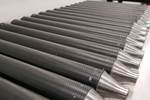Rock West sandwich panels support high-power Astro Digital satellites
RWC built and delivered solar array substrate panels from trace/lead-integrated skins that enable direct integration with solar cells, saving weight and time.
Rock West Composites (RWC, San Diego, Calif., U.S.) announces the delivery of panels for Astro Digital’s (Santa Clara) 500-watt arrays to support higher power versions of its Corvus buses. RWC teamed with Astro Digital to fabricate solar array substrate (SAS) panels with a distinctive integrated design to save volume and weight. These panels are being integrated into space vehicles, the first of which is scheduled to launch in October.
RWC built the SAS sandwich panels from trace/lead integrated-skins that enabled direct integration with solar cells. This reduced total weight and shortened the integration time. The customer furnished the G10 (fiberglass) skins that already had the integrated copper traces. RWC used specialized tooling to align the face skins on the aluminum honeycomb core to keep the traces in the right location during fabrication of the approximately 2 × 2-foot structures.
“This is a great example of how we can help our customers solve their problems in innovative ways,” says Jeremy Senne, space segment director. “It was a tooling and machining challenge to work with their pre-integrated skins, but our experience on other precision programs enabled successful fabrication.”
Related Content
-
A new era for ceramic matrix composites
CMC is expanding, with new fiber production in Europe, faster processes and higher temperature materials enabling applications for industry, hypersonics and New Space.
-
On the radar: Reusable launch vehicles, hypersonics make space more accessible
CFRP has become key to targeting efforts in reusing components like rocket stages, as well as the development of reusable hypersonic testbeds and spaceplanes, for increasing space commercialization.
-
Low-cost, efficient CFRP anisogrid lattice structures
CIRA uses patented parallel winding, dry fiber, silicone tooling and resin infusion to cut labor for lightweight, heavily loaded space applications.














